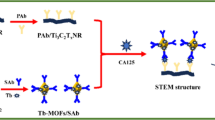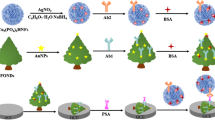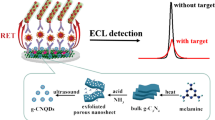Abstract
We developed a near-infrared (NIR) electrochemiluminescence (ECL) immunosensor for sensitively and selectively determining carbohydrate antigen 125 (CA125) with toxic-element-free and environmental-friendly AgInS2/ZnS nanocrystals (NCs) as tags. The core/shell-structured AgInS2/ZnS NCs not only can be conveniently prepared via an aqueous synthetic procedure, but also has high photoluminescence quantum yield (PLQY) of up to 61.7%, highly monodispersed, water-soluble, and desired biological compatibility. As AgInS2/ZnS NCs can be oxidized via electrochemically injecting holes into their valence band at + 0.84 V, both the monodispersed AgInS2/ZnS NCs in solution and the surface-confined AgInS2/ZnS NCs immobilized in sandwich-typed immuno-complexes with CA125 as analyte can exhibit efficient oxidative-reduction ECL around 695 nm under physiological conditions with the presence of tri-n-propylamine (TPrA). The ECL intensity from the AgInS2/ZnS NCs immobilized in sandwich-typed immuno-complexes increases linearly and selectively with an increased concentration of CA125 from 5 × 10−6 to 5 × 10−3 U/mL, and limit of detection (LOD) was 1 × 10−6 U/mL (S/N = 3). This reliable platform can provide an effective detection method in the early diagnosis and treatment of ovarian cancer.
Graphical abstract







Similar content being viewed by others
References
Richter MM. Electrochemiluminescence (ECL). Chem Rev. 2004;104(6):3003–36.
Visco RE, Chandross EA. Electroluminescence in solutions of aromatic hydrocarbons. J Am Chem Soc. 1964;86(23):5350–1.
Wu L, Sha Y, Li W, Wang S, Guo Z, Zhou J, et al. One-step preparation of disposable multi-functionalized g-C3N4 based electrochemiluminescence immunosensor for the detection of CA125. Sensors Actuators B Chem. 2016;226:62–8.
Díez I, Pusa M, Kulmala S, Jiang H, Walther A, Goldmann AS, et al. Color tunability and electrochemiluminescence of silver nanoclusters. Angew Chem Int Ed. 2009;48(12):2122–5.
Sha H, Wang Y, Zhang Y, Ke H, Xiong X, Jia N. Enzyme-free ECL immunosensor based on PbS nanocrystals for highly sensitive detection of alpha fetoprotein. Sensors Actuators B Chem. 2018;277:157–63.
Zhang F, He Y, Fu K, Fu L, Zhang B, Wang H, et al. Dual-wavebands-resolved electrochemiluminescence multiplexing immunoassay with dichroic mirror assistant photomultiplier-tubes as detectors. Biosens Bioelectron. 2018;115:77–82.
Gao X, Fu K, Fu L, Wang H, Zhang B, Zou G. Red-shifted electrochemiluminescence of CdTe nanocrystals via Co2+-doping and its spectral sensing application in near-infrared region. Biosens Bioelectron. 2020;150:111880.
Nelson HD, Gamelin DR. Valence-band electronic structures of Cu+-doped ZnS, alloyed Cu–In–Zn–S, and ternary CuInS2 nanocrystals: a unified description of photoluminescence across compositions. J Phys Chem C. 2018;122(31):18124–33.
Pan ZX, Mora-Sero I, Shen Q, Zhang H, Li Y, Zhao K, et al. High-efficiency “green” quantum dot solar cell. J Am Chem Soc. 2014;136(25):9203–10.
Allen PM, Bawendi MG. Ternary I-III-VI quantum dots luminescent in the red to near-infrared. J Am Chem Soc. 2008;130(29):9240–1.
Bergren MR, Makarov NS, Ramasamy K, Jackson A, Guglielmetti R, Mcdaniel HJAEL. High-performance CuInS2 quantum dot laminated glass luminescent solar concentrators for windows. ACS Energy Lett. 2018;3(3):520–5.
De Trizio L, Prato M, Genovese A, Casu A, Povia M, Simonutti R, et al. Strongly fluorescent quaternary Cu–In–Zn–S nanocrystals prepared from Cu1-xInS2 nanocrystals by partial cation exchange. Chem Mater. 2012;24(12):2400–6.
Stroyuk O, Weigert F, Raevskaya A, Spranger F, Würth C, Resch-Genger U, et al. Inherently broadband photoluminescence in Ag–In–S/ZnS quantum dots observed in ensemble and single-particle studies. J Phys Chem C. 2019;123(4):2632–41.
Hines MA, Guyot-Sionnest PJC. Synthesis and characterization of strongly luminescing ZnS-capped CdSe nanocrystals. J Phys Chem C. 2010;27(19):468–71.
Sakai R, Onishi H, Ido S, Furumi SJN. Effective Mn-doping in AgInS2/ZnS core/shell nanocrystals for dual photoluminescent peaks. Nanomaterials. 2019;9(2):263.
Mao B, Chuang C-H, Wang J, Burda C. Synthesis and photophysical properties of ternary I–III–VI AgInS2 nanocrystals: intrinsic versus surface states. J Phys Chem C. 2011;115(18):8945–54.
Cai C, Zhai L, Ma Y, Zou C, Zhang L, Yang Y, et al. Synthesis of AgInS2 quantum dots with tunable photoluminescence for sensitized solar cells. J Power Sources. 2017;341:11–8.
Talapin DV, Lee J-S, Kovalenko MV, Shevchenko EV. Prospects of colloidal nanocrystals for electronic and optoelectronic applications. Chem Rev. 2010;110(1):389–458.
Zhang K, Lv S, Lu M, Tang D. Photoelectrochemical biosensing of disease marker on p-type Cu-doped Zn0.3Cd0.7S based on RCA and exonuclease III amplification. Biosens Bioelectron. 2018;117:590–6.
Zhang K, Lv S, Zhou Q, Tang D. CoOOH nanosheets-coated g-C3N4/CuInS2 nanohybrids for photoelectrochemical biosensor of carcinoembryonic antigen coupling hybridization chain reaction with etching reaction. Sensors Actuators B Chem. 2020;307:127631.
Montalti M, Cantelli A, Battistelli G. Nanodiamonds and silicon quantum dots: ultrastable and biocompatible luminescent nanoprobes for long-term bioimaging. Chem Soc Rev. 2015;44(14):4853–921.
Tsuji I, Kato H, Kobayashi H, Kudo A. Photocatalytic H2 evolution reaction from aqueous solutions over band structure-controlled (AgIn)xZn2(1-x)S2 solid solution photocatalysts with visible-light response and their surface nanostructures. J Am Chem Soc. 2004;126(41):13406–13.
Stroyuk O, Raevskaya A, Spranger F, Selyshchev O, Dzhagan V, Schulze S, et al. Origin and dynamics of highly efficient broadband photoluminescence of aqueous glutathione-capped size-selected Ag–In–S quantum dots. J Phys Chem C. 2018;122(25):13648–58.
Long X, Zhang F, He Y, Hou S, Zhang B, Zou G. Promising anodic electrochemiluminescence of nontoxic core/shell CuInS2/ZnS nanocrystals in aqueous medium and its biosensing potential. Anal Chem. 2018;90(5):3563–9.
Zhang B, Zhang F, Zhang P, Shen D, Gao X, Zou G. Ultrasensitive electrochemiluminescent sensor for microRNA with multinary Zn-Ag-In-S/ZnS nanocrystals as tags. Anal Chem. 2019;91(5):3754–8.
Zhang X, Tan X, Zhang B, Miao W, Zou G. Spectrum-based electrochemiluminescent immunoassay with ternary CdZnSe nanocrystals as labels. Anal Chem. 2016;88(13):6947–53.
Xiong W-W, Yang G-H, Wu X-C, Zhu J-J. Aqueous synthesis of color-tunable CuInS2/ZnS nanocrystals for the detection of human interleukin 6. ACS Appl Mater Interfaces. 2013;5(16):8210–6.
Martynenko IV, Kusic D, Weigert F, Stafford S, Donnelly FC, Evstigneev R, et al. Magneto-fluorescent microbeads for bacteria detection constructed from superparamagnetic Fe3O4 nanoparticles and AIS/ZnS quantum dots. Anal Chem. 2019;91(20):12661–9.
Wujian M. Electrogenerated chemiluminescence and its biorelated applications. Chem Rev. 2008;108(7):2506–53.
Hesari M, Ding Z. A grand avenue to au nanocluster electrochemiluminescence. Acc Chem Res. 2017;50(2):218–30.
He Y, Zhang F, Zhang B, Zou G. Dichroic mirror-assisted electrochemiluminescent assay for simultaneously detecting wild-type and mutant p53 with photomultiplier tubes. Anal Chem. 2018;90(8):5474–80.
Liang X, Han H, Ma Z. pH responsive amperometric immunoassay for carcinoma antigen 125 based on hollow polydopamine encapsulating methylene blue. Sensors Actuators B Chem. 2019;290:625–30.
Wang S, Ge L, Yan M, Yu J, Song X, Ge S, et al. 3D microfluidic origami electrochemiluminescence immunodevice for sensitive point-of-care testing of carcinoma antigen 125. Sensors Actuators B Chem. 2013;176:1–8.
Samadi Pakchin P, Ghanbari H, Saber R, Omidi Y. Electrochemical immunosensor based on chitosan-gold nanoparticle/carbon nanotube as a platform and lactate oxidase as a label for detection of CA125 on comarker. Biosens Bioelectron. 2018;122:68–74.
Büyüktiryaki S, Say R, Denizli A, Ersöz A. Phosphoserine imprinted nanosensor for detection of cancer antigen 125. Talanta. 2017;167:172–80.
Torati SR, Kasturi KCSB, Lim B, Kim C. Hierarchical gold nanostructures modified electrode for electrochemical detection of cancer antigen CA125. Sensors Actuators B Chem. 2017;243:64–71.
Wang M, Hu M, Li Z, He L, Song Y, Jia Q, et al. Construction of Tb-MOF-on-Fe-MOF conjugate as a novel platform for ultrasensitive detection of carbohydrate antigen 125 and living cancer cells. Biosens Bioelectron. 2019;142:111536.
Funding
The work in this paper received support from the Shandong Keypoint Research & Development Plan (grant references: 2018GSF117006, and 2019GSF109063), Shandong Province TaiShan Scholar Program (ts20190948), and the National Natural Science Foundation of China (NSFC) (grant references: 21703126).
Author information
Authors and Affiliations
Corresponding author
Ethics declarations
The human serum samples in this study were bought from Beijing Century Aoke Biotechnology Co., Ltd. (Beijing, China). In addition, these studies were approved by the ethics committee of Qilu University of Technology, and in accordance with the ethical standards “Qilu University of Technology” and with the 1964 declaration of Helsinki and its later amendments or comparable ethical standards.
Conflict of interest
The authors declare no conflict of interest.
Additional information
Publisher’s note
Springer Nature remains neutral with regard to jurisdictional claims in published maps and institutional affiliations.
Supplementary information
ESM 1
(PDF 528 kb)
Rights and permissions
About this article
Cite this article
Yin, M., Wang, Y., Gao, X. et al. Electrochemiluminescence ultrasensitive immunoassay for carbohydrate antigen 125 based on AgInS2/ZnS nanocrystals. Anal Bioanal Chem 413, 2207–2215 (2021). https://doi.org/10.1007/s00216-021-03191-0
Received:
Revised:
Accepted:
Published:
Issue Date:
DOI: https://doi.org/10.1007/s00216-021-03191-0




